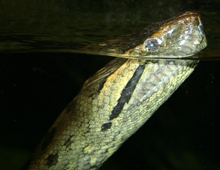The River's Edge

Saffron toucanet, Pteroglossus bailloni
This toucanet is easily identified by its saffron yellow head and breast, olive mantle and red rump. Sexes are similar but the female is duller (somewhat more olive in color) and the bill is shorter. The greenish-horn bill has red patches surrounded by yellowish-gray at the base. The rump and ocular skin are red. The iris is pale yellowish.
LEARN MORE
Cardinal tetra, Paracheirodon axelrodi
This popular aquarium fish was unknown to science until 1956, when ichthyologists at the Smithsonian Institution and Stanford University published descriptions a day apart. It took a meeting of the International Commission on Zoological Nomenclature to determine the Smithsonian had published first. Found only in the Rio Negro and Orinoco Rivers, they are provided both through ecologically sustainable collecting in Brazil and fish farms in Asia and Europe.
LEARN MORE
Green anaconda, Eunectes murinus
Exceeding 20 feet in length and 300 pounds in weight, this famous South American snake is by far the largest of the boas, and is the heaviest of the world’s snakes (the Reticulated python from Asia may grow slightly longer). Anacondas give birth to live young, usually 20 to 40 at a time. With their eyes near the top and end of their heads, they are adapted to an aquatic environment, and most of their prey is taken in or near water. At the DWA, they are fed rats. The largest specimen here is 14 feet long.
LEARN MORE
Blue poison dart frog, Dendrobates azureus
When these amazing frogs first appeared in zoos in the 1970s, they created a sensation and remained very rare in collections until the mid-1980s. They are now widespread in captivity, thanks to their popularity. As with other poison dart frogs, captive-bred animals raised on fruit flies and crickets lose their toxic qualities. Found only on a few “islands” of forest, arising out of the Sipaliwini savannah of Suriname and Brazil, they are considered vulnerable to extinction, so that their status as a self-sustaining captive population is especially satisfying.
LEARN MORE
Budgett’s frog, Lepdibatrachus laevis
Named after J. S. Budgett, who studied lungfish, bichers, and amhibians in South America and Africa over a hundred years ago, this unique frog could be said to resemble a cross between a hippopotamus and a potato. Even the tadpoles have enormous mouths and are cannibals, making their propagation difficult for amphibian keepers. They do not have teeth, but can inflict painful bites with sharp-edged structures in the jaws. Found in Paraguay, Argentina, and Bolivia, these relatives of the horned frogs were very rare in captivity before the 1980s.
LEARN MORE
Black-banded leporinus, Leporinus fasciatus
Growing to a foot in length, this eye-catching relative of tetras and piranhas is a typical inhabitant on flooded forests in South America. For more than 50 years it has been very popular in the pet trade. While having a reputation for harassing other fishes in home aquariums, it is not aggressive in roomy accommodations.
LEARN MORE
Polka-dot stingray, Potamotrygon leopoldi
This species has a restricted range in South America, found only in the Xingu River Basin of Brazil, creating a concern that mining or other polluting activities could threaten it. Because of its striking pattern, it is highly valued for aquarium displays, and is now being captive bred around the world.
LEARN MORE

